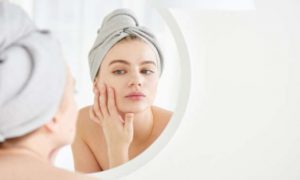Can face masks help slow the spread of the virus that causes coronavirus disease 2019 (COVID-19)? Yes. Face masks combined with other preventive measures, such as getting vaccinated, frequent hand-washing and physical distancing, can help slow the spread of the virus that causes COVID-19.
The U.S. Centers for Disease Control and Prevention (CDC) recommends masks for the general public. If you’re fully vaccinated and are in an area with a high number of new COVID-19 cases, the CDC recommends wearing a mask indoors in public and outdoors in crowded areas or when you are in close contact with unvaccinated people. People who haven’t been fully vaccinated should wear face masks indoors and outdoors where there is a high risk of COVID-19 transmission, such as crowded events or large gatherings.
The CDC says that you should wear the most protective mask possible that you’ll wear regularly and that fits. Respirators such as nonsurgical N95s give the most protection. KN95s and medical masks provide the next highest level of protection. Cloth masks provide less protection. The CDC says that surgical N95 masks should be reserved for health care providers.
How do the different types of masks work?
Medical masks
Also called surgical masks, these are loosefitting disposable masks. They’re meant to protect the wearer from contact with droplets and sprays that may contain germs. A medical mask also filters out large particles in the air when the wearer breathes in.
To make medical masks more form-fitting, knot the ear loops where they attach to the mask. Then fold and tuck the unneeded material under the edges.
Wearing a medical mask doesn’t increase the level of carbon dioxide in the air you breathe.
KN95 masks
A KN95 mask is a type of respirator that meets certain international standards. It offers more protection than a medical mask does because it filters out both large and small particles when the wearer inhales. However, be cautious when buying a KN95, as many fake masks are sold that don’t meet quality requirements.
N95 masks
An N95 mask is a type of respirator that meets U.S. quality standards. An N95 offers the highest level of protection. It offers more protection than a medical mask does because it filters out both large and small particles when the wearer inhales. Non-surgical N95s can be used by the general public.
The CDC has said surgical N95 masks should be reserved for health care providers. Health care providers must be trained and pass a fit test before using a surgical N95 mask. Like surgical masks, N95 masks are intended to be disposable. However, researchers are testing ways to disinfect and reuse them.
Some N95 masks, and even some cloth masks, have valves that make them easier to breathe through. Unfortunately, these masks don’t filter the air the wearer breathes out. For this reason, they’ve been banned in some places.
Cloth masks
A cloth mask is intended to trap respiratory droplets that are released when the wearer talks, coughs or sneezes. It also acts as a barrier to protect the wearer from inhaling droplets released by others.
The most effective cloths masks are made of multiple layers of tightly woven fabric like cotton. A mask with layers will stop more droplets from getting through your mask or escaping from it.
Wearing a mask doesn’t increase the level of carbon dioxide in the air you breathe.
If you wear a gaiter, make sure it has at least two layers of cloth.
How to get the most from your mask
The effectiveness of cloth and medical masks can be improved by ensuring that the masks are well fitted to the contours of your face to prevent leakage of air around the masks’ edges.
Masks should be snug over the nose, mouth and chin, with no gaps. You should feel warm air coming through the front of the mask when you breathe out. You shouldn’t feel air coming out under the edges of the mask.
Choose masks that have bendable nose strips, as these help prevent air from leaking out of the top of the mask.
Masks with several layers offer more protection. Some people choose to wear a medical mask under their cloth mask. In that case, the cloth mask should press the edges of the medical mask against the face. Don’t add layers if they make it hard to breathe or block your vision. And don’t use another mask with a KN95 or N95.
If you wear a KN95 or N95, make sure it fits and seals close to your face.
A child’s mask should be specifically made for children in order to fit properly. Make sure it fits snug over the nose, mouth and chin.
Proper use, storage and cleaning of masks also affects how well they protect you. Follow these steps for putting on and taking off your mask:
- Wash or sanitize your hands before and after putting on your mask.
- Place your mask over your mouth and nose and chin.
- Tie it behind your head or use ear loops. Make sure it’s snug against your face.
- Don’t touch your mask while wearing it.
- If you accidentally touch your mask, wash or sanitize your hands.
- If your mask becomes wet or dirty, switch to a clean one. Put the used mask in a sealable bag until you can get rid of it or wash it.
- Remove the mask by untying it or lifting off the ear loops without touching the front of the mask or your face. Fold the outside corners together.
- Wash your hands immediately after removing your mask.
- Regularly wash cloth masks in the washing machine or by hand. (They can be washed along with other laundry.) Dry them in the dryer or hang them outside in the sun.
- Throw away disposable masks after wearing them once.
And don’t forget these precautions:
- Don’t put masks on anyone who has trouble breathing or is unconscious or otherwise unable to remove the mask without help.
- Don’t put masks on children under age 2.
- Don’t use face masks as a substitute for physical distancing.
What about face shields?
The CDC doesn’t recommend using face shields instead of masks because it’s unclear how much protection shields provide. However, wearing a face mask may not be possible in every situation. If you must use a face shield instead of a mask, choose one that wraps around the sides of your face and extends below your chin.
Do you still need to wear a face mask after you’re fully vaccinated?
After you are fully vaccinated, you can more safely return to doing activities that you might not have been able to do because of the pandemic. However, if you are in an area with a high number of new COVID-19 cases, the CDC recommends wearing a mask indoors in public and outdoors in crowded areas or when you are in close contact with unvaccinated people. You’re considered fully vaccinated two weeks after you get a second dose of an mRNA COVID-19 vaccine or two weeks after you get a single dose of the Janssen/Johnson & Johnson COVID-19 vaccine.
In the U.S., everyone also needs to wear a mask while on planes, buses, trains and other forms of public transportation.





























